This information is for Queensland residents. Electricity bills and tariffs will vary state to state, so please keep this in mind when completing your research.
This blog forms part one of our Queensland Bill Hunter series, where we are on the lookout for the worst electricity bill in QLD. Think you might have the worst bill? Submit it to us here and we will review it, provide an analysis, and offer recommendations for improvement.
In this series, we are exploring five different bill types and tariffs:
Five Part Series
1. Flat rates and off-peak charges
2. Flat rates with demand charges
3. Commercial demand electricity bills
4. Electricity bills when you have a solar system
5. Electricity bills when you have a solar system and a battery
This blog offers an in-depth guide on:
- How to read your electricity bill when you have a solar system installed at your property, and
- How to read your electricity bill when you have a solar system and a battery installed.
We will review how to determine how much your solar is actually saving you in electricity costs, and how much solar you are exporting back to the grid.
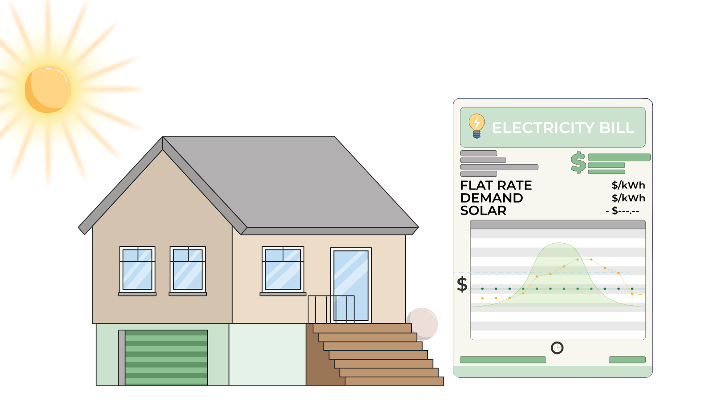
We will share two examples of real electricity bills below. The first is a home that has a solar system installed, and is charged a residential flat rate, demand charge, and is credited a solar export. This bill actually belongs to one of our directors, Eddie Springer, so he will provide insight into his home's energy consumption patterns and how that influences the charges on his electricity bill.
The second electricity bill belongs to a home that has a solar system and a solar battery installed. This bill is similar to the first example, but you'll notice that the kWh charges are reduced further and the solar export is also reduced.
But before we dive in, let's define the different rates and tariffs you will find on a typical residential electricity bill.
Read more: Queensland electricity prices to increase by up to 22%
What is a flat rate electricity charge?
A flat rate, or single rate electricity bill, is a bill where you get charged for the electricity you consume in your property at one singular rate. This singular rate is applied to all general usage of electricity in your property.
This singular rate is a set rate of cents per kilowatt hour for the entire bill. This rate will not change depending on the time of day, time of use, or for the demand you're using on the bill.
What is an off-peak electricity charge?
An off-peak rate is an additional rate that is applied to the use of your hot water system. This is a separate charge to general usage, reserved for electricity used to heat your hot water unit. It is often referred to as a controlled load in your bill charges section.
Like the rate charged for your general usage, the off-peak rate is a flat tariff.
We won't see off-peak charges on the example bills below as both homes have a hot water controller installed, which eliminates this charge. The hot water controller diverts solar energy to heat the hot water system, negating the need to draw grid electricity completely.
What is the demand electricity charge?
The demand charge on your electricity bill is where the retailer is charging you for the highest usage for the month. This highest usage charge is the instantaneous highest electricity use between 4pm-9pm. That highest instantaneous usage will then be charged to you over a 30-day period.
For example, if you average 5kW usage in your home every evening (4pm-9pm) in the month of January, but then on January 20th you decided to run all your appliances at once and use 10kW of electricity at 5pm, your electricity retailer would note that as being your highest point of energy usage. That 10kW usage is applied across the entire month and you are charged that instantaneous point multiplied by 30 days, even if you don't use 10kW of energy every evening.
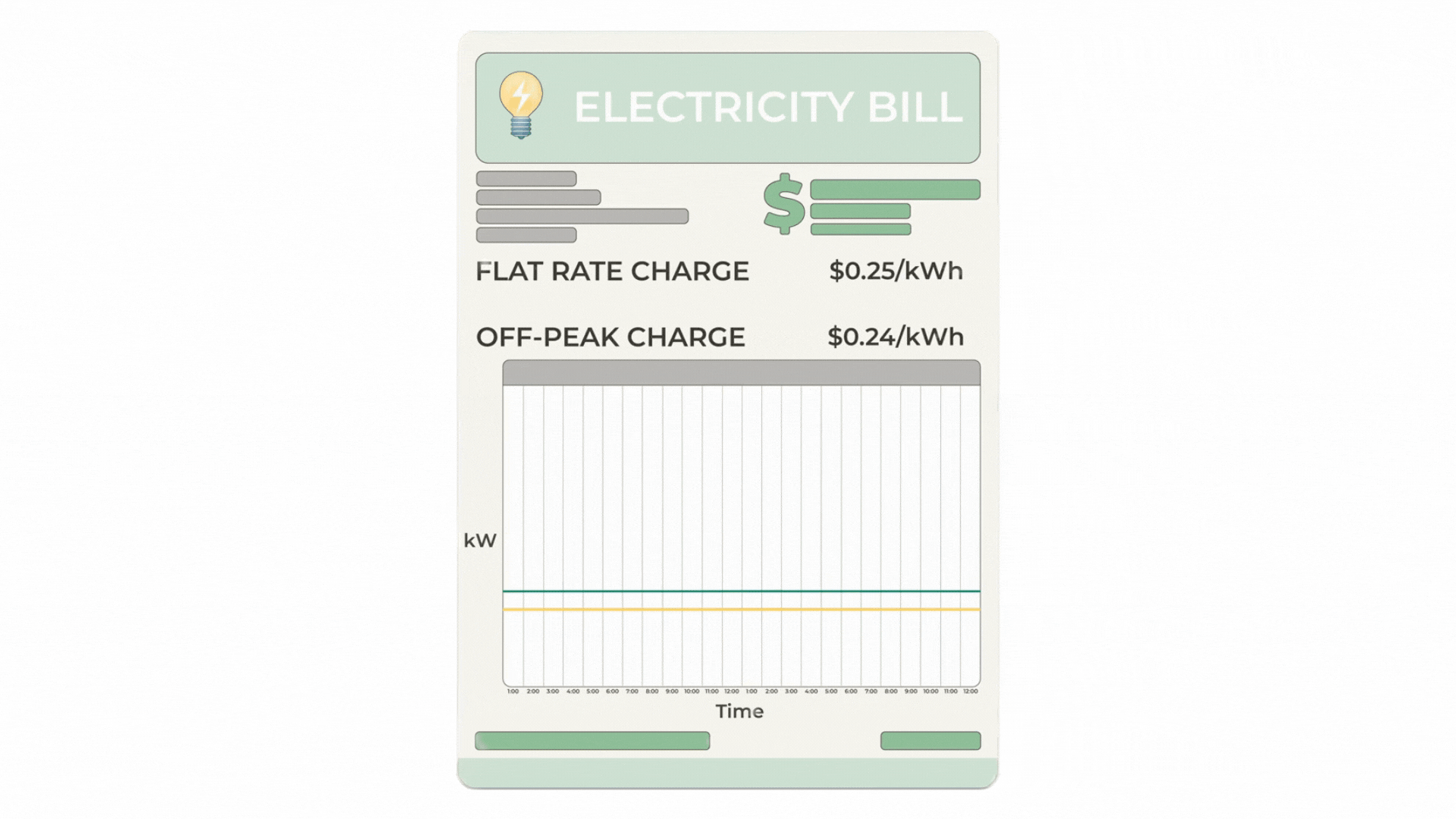
What is the solar export credit?
The solar export on your electricity bill tells you how much solar energy you have exported to the grid because it was not consumed in your home. The solar export credit can be deceiving - you may look at this and think that your solar system has only produced X amount of kWh which has resulted in a credit of X amount of dollars.
But that's not what your solar export is telling you. Your electricity bill won't show you how much of your solar energy you have actually used in your home, only the excess solar that wasn't needed and was exported to the grid.
The solar export credit is the amount your electricity retailer pays you for this export. Your retailer will have given you a set feed-in tariff which dictates how much they pay per kWh you export. The higher your feed-in tariff, the more you will earn in credits.
Read more: Feed-in tariffs vs. solar system sizing
To work out how much your solar energy system is contributing to the savings on your peak, off-peak, and demand charges, you need to know how big your solar system is and how much it is estimated to produce each day. If you do these calculations, you can work out how much your grid electricity consumption has been reduced.
We will share an example of this and how to work out your solar consumption further down.
Example electricity bill 1
House with a solar system
One of Springers Solar's directors, Eddie Springer, has shared his bill so we can demonstrate what an electricity bill looks like when you have a solar system installed.
You're probably aware that electricity bills all look slightly different depending on the retailer, but all bills are broken down into sections. The most important sections you need to pay attention to are the charge descriptions and the solar export - keep scrolling to find out where these are and how to read them.
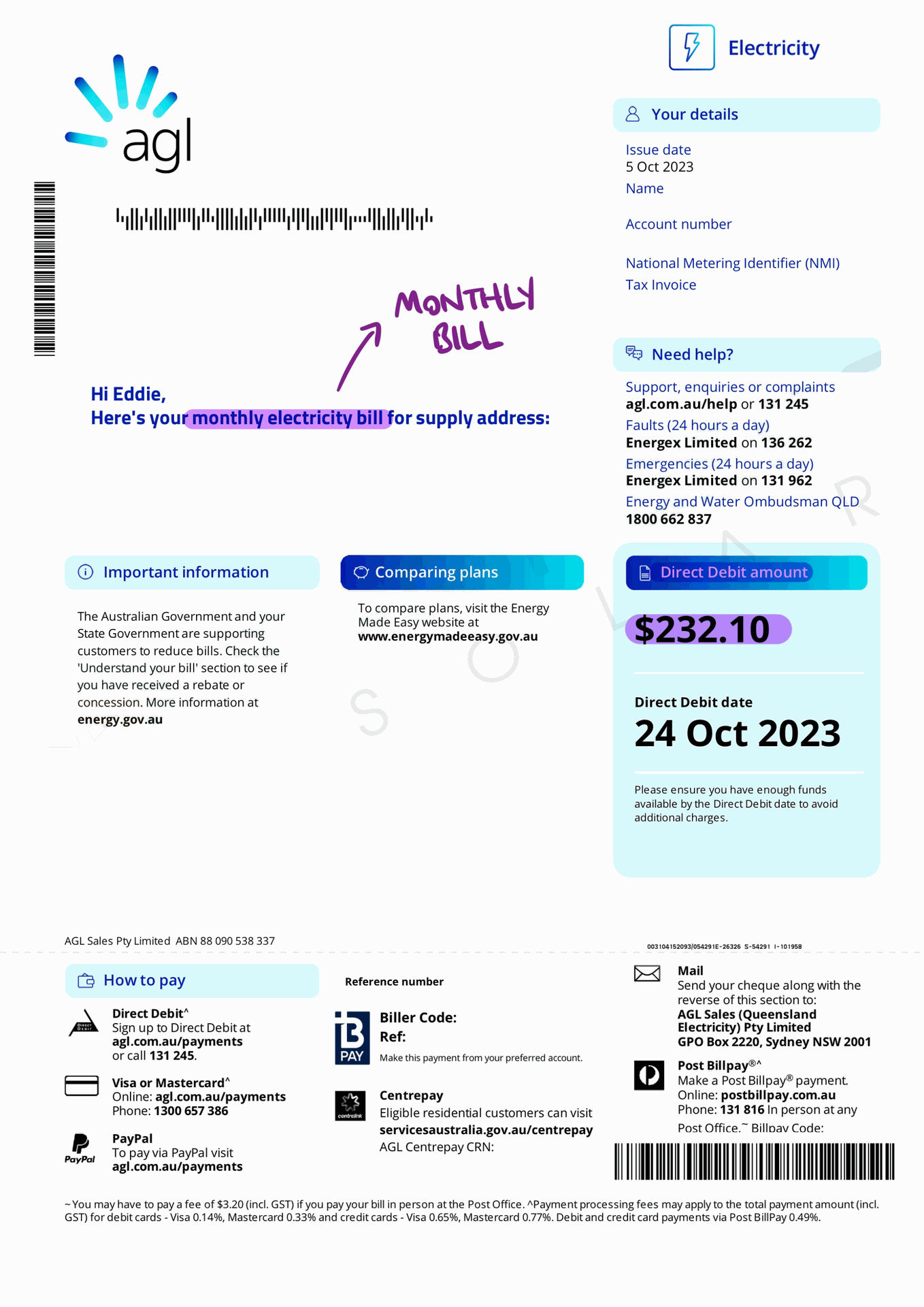
Page 1
Page one of this bill displays the billing period and a quick look at the total amount due. Other retailers will also display your energy usage summary, which is helpful to see how your usage compares with similar properties, to indicate how much electricity you are consuming, and whether or not you are using in excess.
The majority of people will look at the total amount due figure, pay the bill, and call it a day. But this figure doesn't show you any of the charges contributing to the total cost, rendering you blind to the most important aspects of your bill (what you're actually being charged).
There are many factors contributing to this total amount due, and we want to find out what. So, let's ignore the total amount due, and continue.
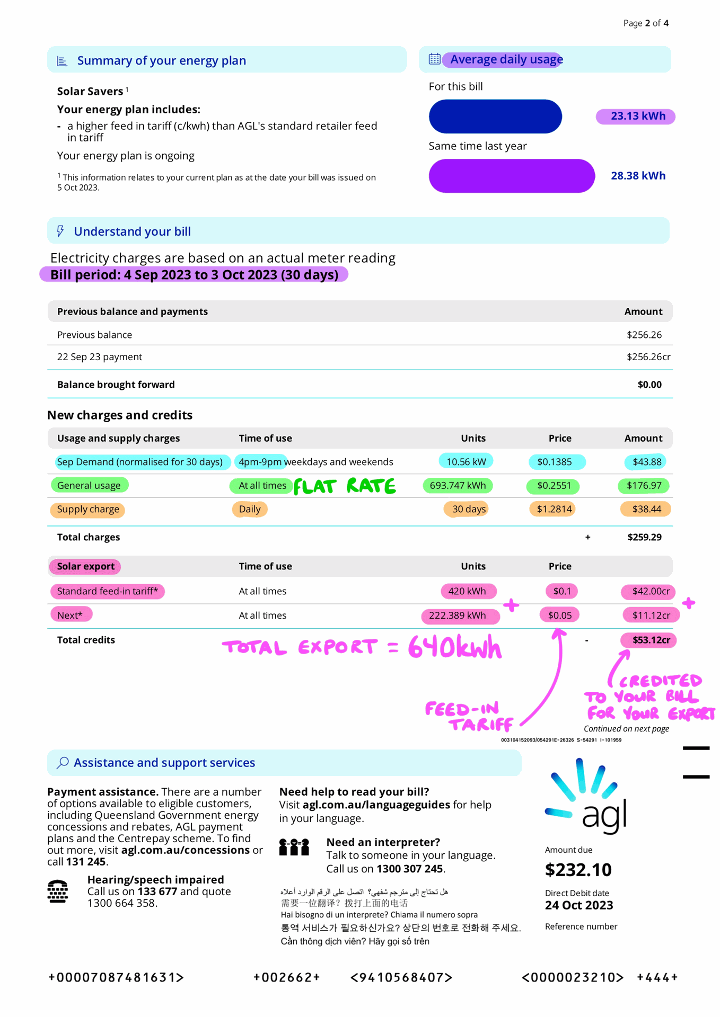
Page two has the good stuff. This is where you can see the breakdown of your charges and credits. At first glance, it can be quite confusing, so let's break it up to understand what's going on here.
This bill has three charges listed:
1. Sep demand (normalised for 30 days): this is the demand charge
2. General usage: this is the flat rate
3. Supply charge: this is the daily rate
You can also see Eddie's average daily usage for the month, sitting at 23.13kWh. While this is on the higher end of the usage scale, it's important to note that Eddie runs a lot of appliances in his family home, including an EV charger and a pool. Keep this in mind when we begin to analyse his usage and where this usage is being charged.
Let's look at his demand charge. We can see that he is being charged at 10.56kW at a rate of $0.138. 10.56kW was the highest instantaneous point of electricity usage in his home during the peak period (4pm-9pm). Because this peak period occurs once the solar has begun to decrease production for the day, Eddie's solar system isn't contributing a lot to offset this demand charge.
Eddie notes that he has a bad habit of charging his EV after he gets home from work during that peak period. Charging his EV at this time is a mistake that is contributing to that high demand charge on his bill. Instead, he should be charging his EV overnight when the cost of electricity is lower, or charging on weekends when he can offset the usage with his solar system.
Moving along to the general rate, or flat rate. This is the charge that is really being attacked by his solar energy system, as this is the charge for all other times of the day. Eddie's solar system will be offsetting the majority of his electricity usage during the day, and the grid will only be supplementing his property on cloudy days, during the peak period once the solar has rolled off for the day, and overnight.
The supply charge is a set rate from the retailer that you are charged every day. There isn't much you can do about that charge, except shop around for other retailers or plans.
Solar Export
The next section is where we can begin to see how the solar system is contributing to the bill. This is called Solar Export, and we can see two items listed here:
1. Standard feed-in tariff*: this is the rate your retailer has agreed to pay you per kWh you export back to the grid.
2. Next*: this is the secondary rate you will receive per kWh if you have exceeded the maximum amount of kWh units of export for your primary FIT (feed-in tariff).
We can see for this month, Eddie exported 420kWh of solar energy to the grid at a rate of $0.10 per kWh. After reaching that 420kWh unit limit, the retailer then pays Eddie $0.05 per kWh of export for the remaining 222.38kWh that was exported.
This export resulted in a credit on his electricity bill for $53.12. You may initially look at this and think, "Wow, his solar is only contributing a saving of $53 on his bill", but that isn't true. What we don't see on electricity bills is how much solar has been self-consumed by the property. The $53.12 is simply an added benefit received from generating excess solar that wasn't needed within the home.
So, how do you figure out how much your solar is saving you in bill charges via solar self-consumption? A little bit of math is involved.
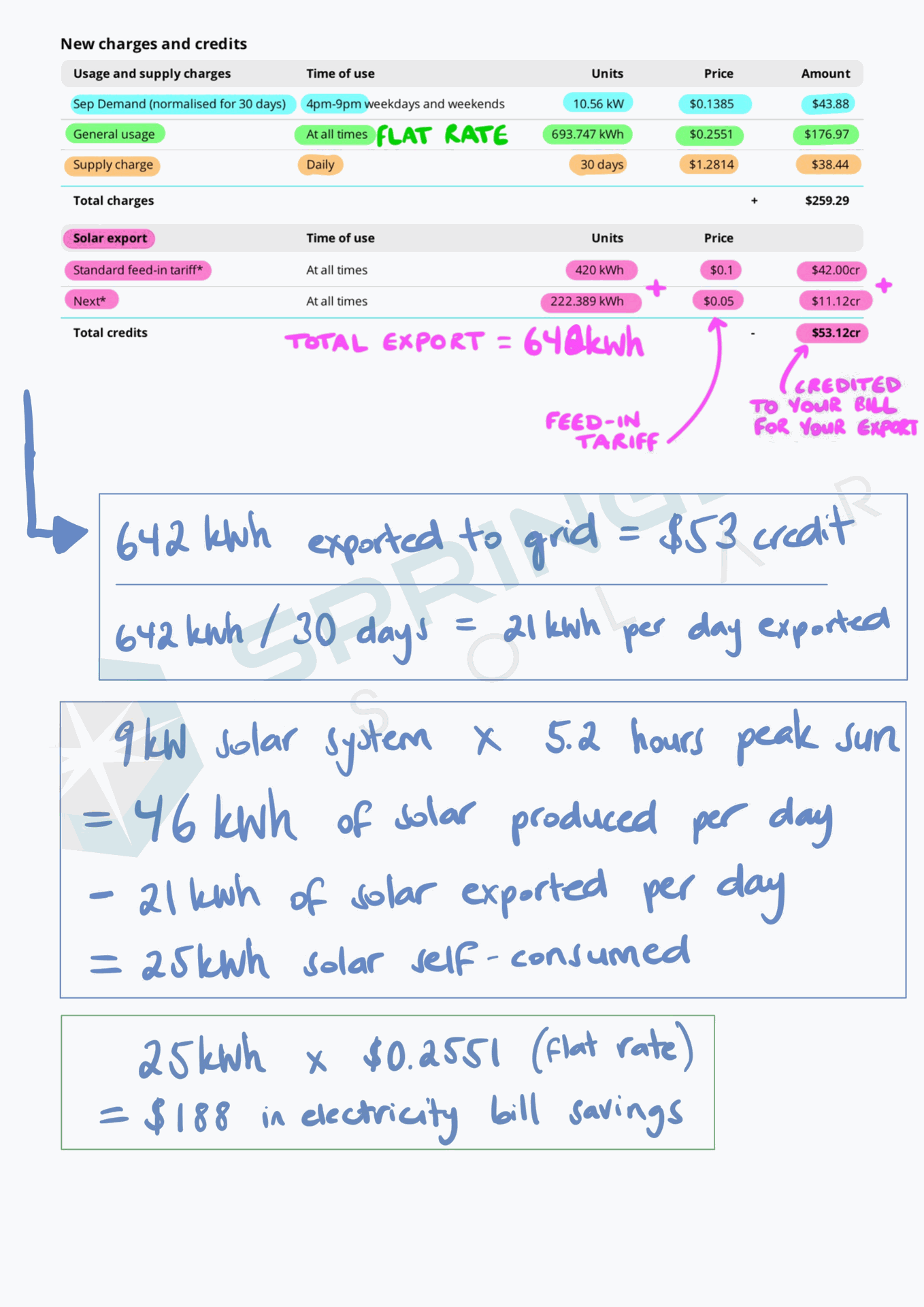
First, you need to know how many kW of solar you have on your roof. This will help you determine how many kWh of solar your system is producing every day. If you have a monitoring app, you can even check your data to see how much it is producing on average every day.
Eddie has a 9kW system on his roof. Brisbane generally receives around 5.2 hours of peak sun per day, so a 9kW system x 5.2 hours will generate approximately 46kWh of solar energy per day.
Of that 46kWh solar production, Eddie exports around 21kWh of solar per day back to the grid (642kWh exported / 30 days). Therefore, we can deduce that Eddie's home consumes approximately 25kWh of solar energy every day which isn't being shown on the bill.
To work out a dollar saving, we can multiply 25kWh by his general usage rate of $0.255 to estimate that his solar saved him approximately $188 in electricity bill charges. All because his home used solar energy rather than grid electricity for that 25kWh of usage. Pretty awesome!
Read more: Pros and cons of solar energy in 2024
How to save money on this electricity bill
1. Reduce usage during peak periods to lower the demand charge
The best thing that Eddie could do to reduce his monthly bill is to ensure that he isn't using energy-intensive devices, like his EV charger, during the 4pm-9pm peak period. The less electricity you use during this period, the more you will save.
If it's possible, we'd recommend running as many of those energy-intensive activities during the day to offset the usage with solar. Or, if you're not home during the day, running those appliances overnight after 9pm to avoid that peak period.
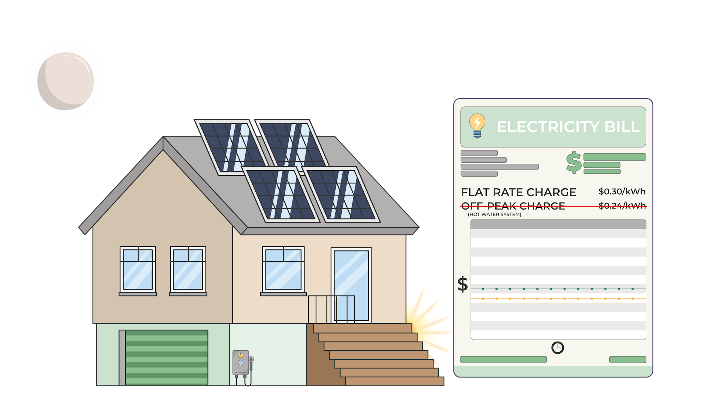
2. Reduce general usage kWh by improving solar self-consumption
The key to maximising savings on your general usage charge is to use as much solar energy during daylight hours as possible. This is called solar self-consumption, and it is the most effective way to reduce your general usage charge and lower your solar system payback period.
Read more: How to improve your solar self-consumption with load shifting
To improve your solar self-consumption, you should aim to shift as much of your electricity usage to the daytime (as possible). For example, ensure you're using the washing machine, dishwasher, pool cleaner, temperature control, and other heavy energy users during the day. As soon as you start using these appliances at night, you are using energy from the grid, therefore increasing your general usage kWh and costing you money.
Since we know that Eddie is exporting around 21kWh of solar energy a day, that's 21kWh that he could have self-consumed to further reduce his general usage units.
Read more: 5 ways to maximise your solar energy consumption
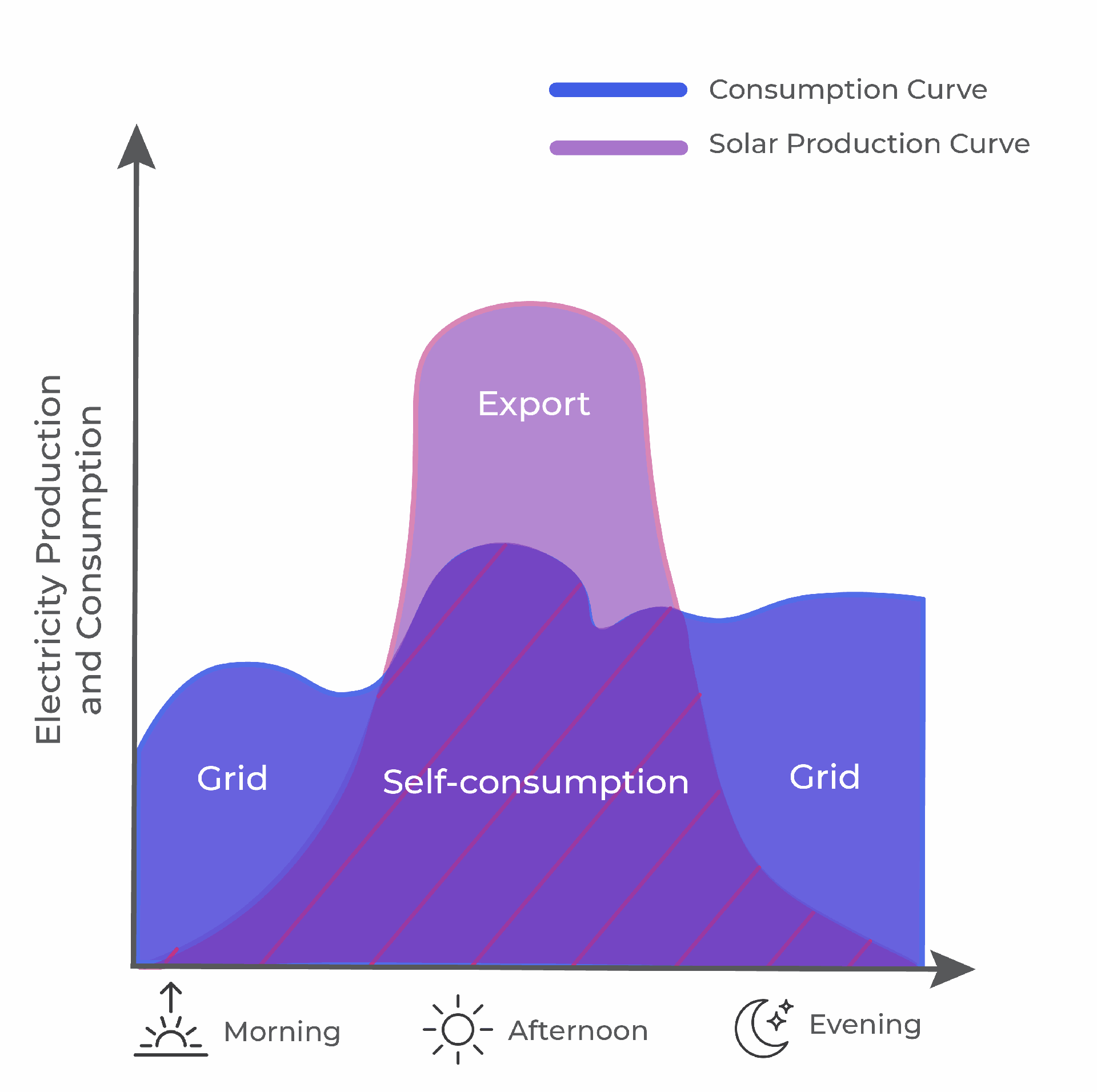
3. Eliminate the demand charge and general usage kWh by installing a solar battery
If you're interested in going the extra kilometre and would like to completely eliminate the general usage charge on your electricity bill, we would recommend installing a solar battery.
A solar battery allows you to store excess solar energy your system produces during the day so that you can access it during the evening and at night. By using excess solar energy at night, you avoid pulling energy from the grid, reducing your demand charge and general usage charge to almost nothing. Pretty cool, right?
Read more: Store your excess solar energy with a solar battery

Read more: Maximising solar energy with Tesla Powerwall
If your household uses a significant amount of energy and your general usage charge is exorbitant, then a solar battery may be a wise investment. The QLD Government is soon releasing a solar battery rebate for Queensland homeowners that you may be eligible for - learn more about it here.
Let's look at how much a solar battery can actually reduce your bill by.
Example Electricity Bill 2
House with solar and a battery
Everyone talks about how beneficial solar batteries can be, but how much does it actually help your electricity bill? We have a real bill from one of our customers to demonstrate how well they can perform, and how much your bill can shrink.
This bill is also an AGL bill, so it will look fairly similar. But you'll notice the charges are far more decreased, even though it is a similar household in size. Note that this bill is also charging a monthly billing period.
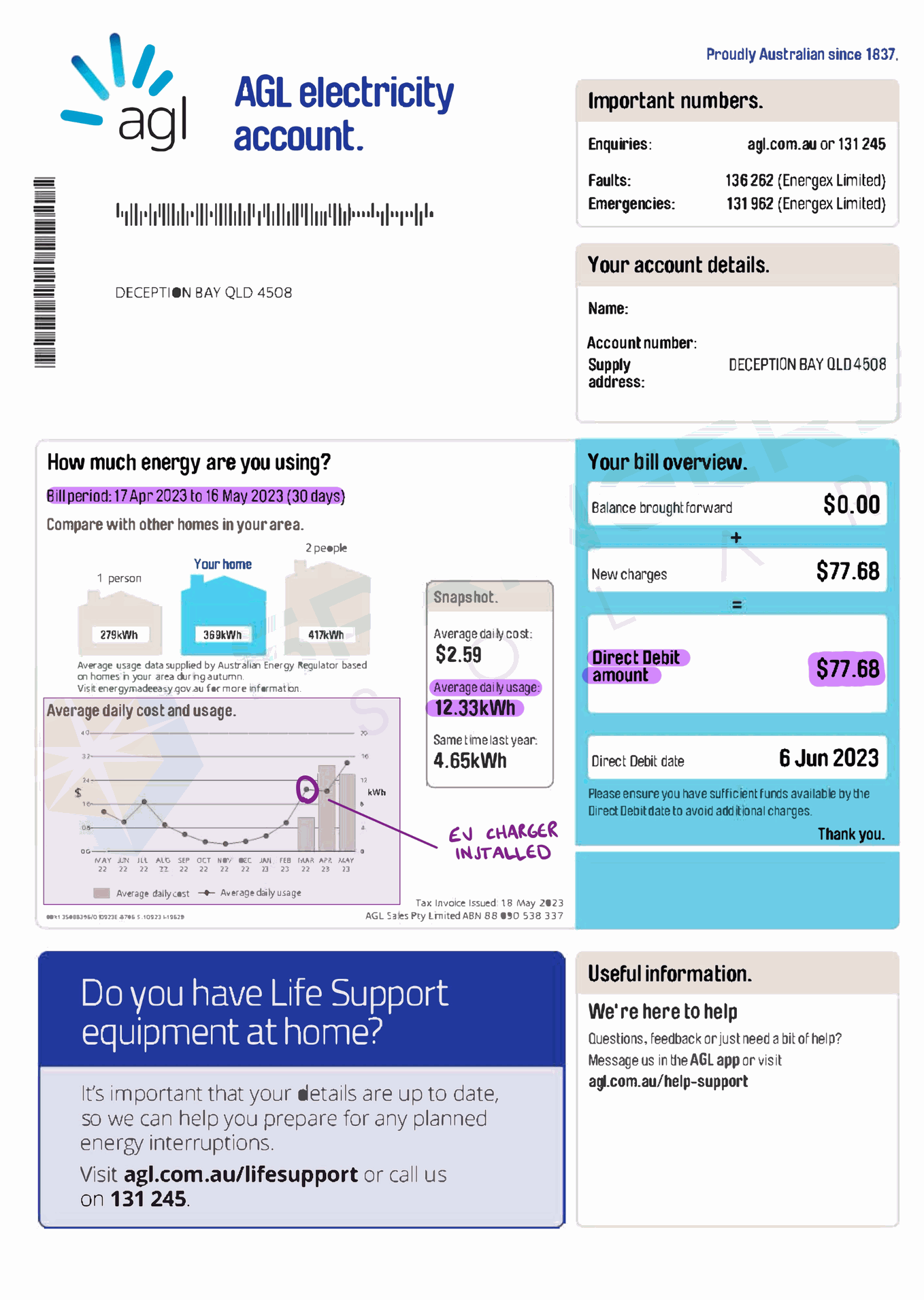
Just like the first example, page one of this bill shows the billing period of 30 days, the average daily usage of 12.33kWh, their energy usage over time, and the total amount due.
Although we still aren't too concerned with the total amount due, we can already see that this bill is significantly more affordable than the other bills we have presented in this series. But why isn't it $0 if they have a battery? Let's find out.
This customer has had their solar system for a few years now, but they installed a Tesla Powerwall at their property in the third quarter of 2022. We can actually see on the graph above how the battery decreased their average daily usage. We also know that the customer then installed an EV charger in early 2023, hence the rising line, indicating that more power is being drawn from the grid.
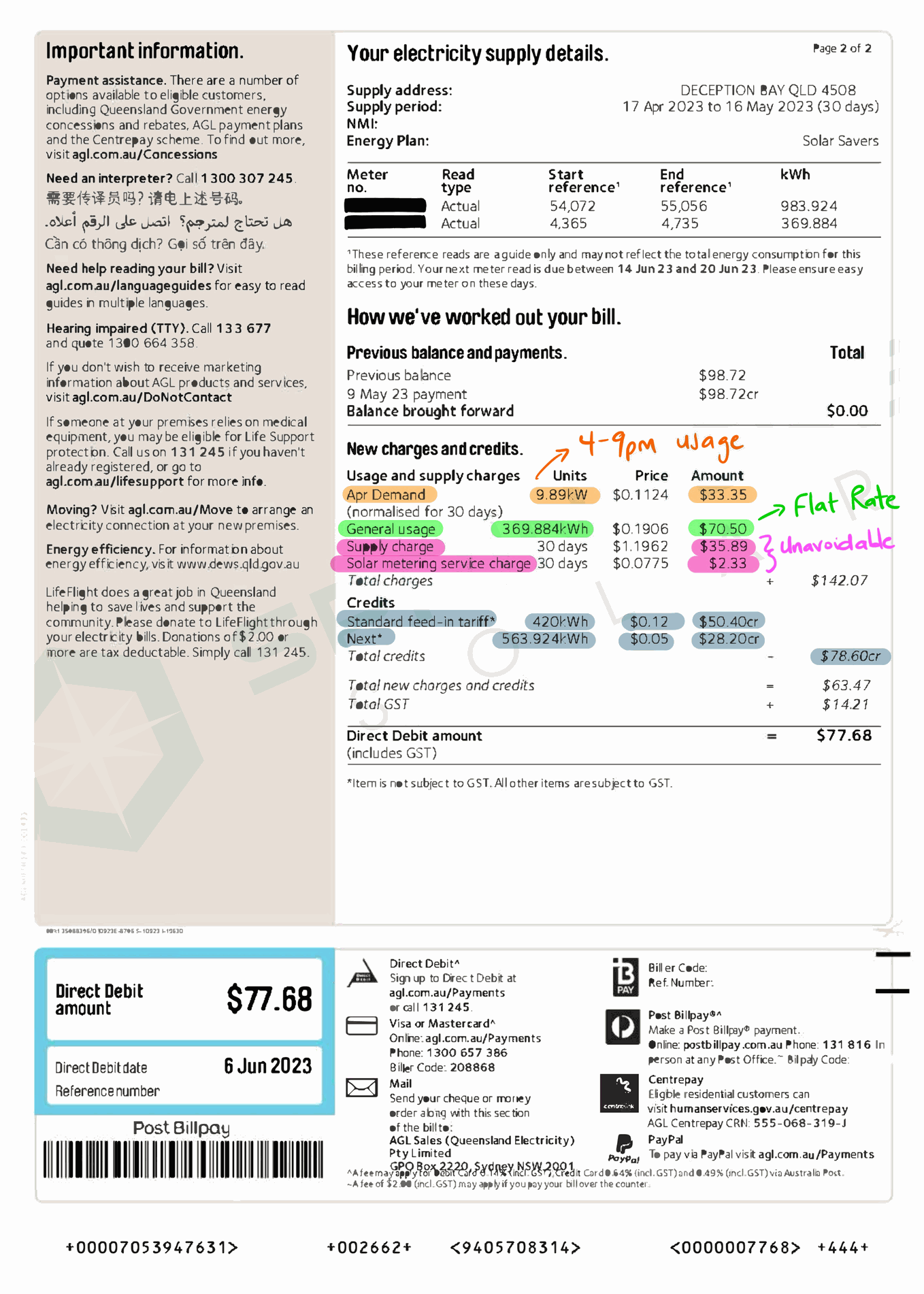
Page two again shows all our charges and credits in detail. As you can see, it's presented the same as the first example, with a demand charge, a general usage (flat rate) charge, and solar export credits. It also includes the daily supply charge and daily solar metering service charge.
This bill has shows that the household has still used a decent amount of demand electricity, even considering the solar and battery system. This is potentially the result of a day or two of significant cloud cover and the battery was depleted. If the battery was depleted during the demand peak period (4pm-9pm), then electricity from the grid would have been drawn to power evening usage. This is likely why we have a demand charge on this bill.
We can see that the general usage for the period is 369.8kWh, which when divided by 30 days, equates to an approximate daily usage of 12.3kWh. This is very low for a family home with an EV charger, a pool, and modern appliances. The solar system on this property would be significantly offsetting their daytime usage, and the battery would be discharging overnight to prevent draw from the grid even when the sun isn't shining.
The supply charge and the solar metering service charge seen on this bill are unavoidable charges from AGL and most other electricity retailers. These are charges the retailer instils as part of their service agreement.
Solar Export
When you have a solar and battery system installed at your property, you will notice that your solar export credits would decrease in comparison to a property with only a solar system installed.
This is for one reason: your battery charges itself with excess solar energy that would have otherwise been exported to the grid.
This results in you exporting less solar to the grid, but consuming more solar energy within your home, even once the sun has set. You can think about this process in three basic steps:
- Your solar system produces solar during the day and will power your home while the sun is shining.
- Excess solar energy not used by your home during the day will be diverted to your battery bank for charging.
- Once your battery is fully charged, any extra excess solar will be exported to the grid for a small credit on your bill.
Similar to the first bill, AGL has an agreement with this customer to pay a feed-in tariff of $0.12 per kWh for the first 420kWh units, and any additional export will be paid at a rate of $0.05 per kWh. For this customer, that resulted in a solar export credit of $78.60.
Considering how large this home's solar system is, how many appliances the home runs daily, and how little their monthly electricity bill is charged, this is an indication that the key to maximising your solar savings is to use as much of your solar possible, which is possible with a solar battery that you can access overnight.
In summary, the addition of a solar battery to your home can be an incredibly successful way to stretch your solar energy further and completely reduce your reliance on the grid. Grid electricity becomes the backup source of power, rather than the primary source.
How to save money on this electricity bill
1. Reduce usage during peak periods to lower the demand charge
To avoid the additional $33 demand charge on this bill, this property owner should pay close attention to when they choose to charge their electric vehicle. Avoid using energy-intensive appliances during the 4pm-9pm peak period and instead charge either while the sun is shining and it can be offset with solar, or charge overnight when the cost of electricity is reduced.
This will help avoid a demand charge if the battery is unable to compensate for that usage due to insufficient charging from cloudy weather or extreme usage.
2. Reduce general usage charge
The $70 general usage charge is very low considering this household's usage patterns, so there probably isn't too much more that this homeowner can do to reduce this charge. We would always recommend shifting as much of their usage as possible to the daytime to be offset by solar, but it is likely that this $70 charge is coming from either overnight temperature control once the battery has depleted, or on cloudy days where grid electricity has had to chip in.
Additional batteries can help eliminate the general usage charge altogether as you can store more solar electricity, but this can be a costly option that isn't suitable for every property. Have a chat to a certified solar and battery installer (like us!) to find out whether batteries are the right option for you.

Springers Solar | Queensland's Most Experienced Solar Installer
Springers Solar provides quality components with proven performance, backed by industry-leading warranties, and dedicated after-sales support. Thousands of satisfied customers over more than 21 years of operation make Springers Solar one of the most established and experienced solar companies in Australia.
Springers Solar has received multiple awards for design and installation and is a certified/preferred installer for a large range of solar panel, inverter, and solar battery manufacturers, including Tesla, REC, and SolarEdge.
Our dedicated in-house team of electrical engineers, project managers, solar PV designers, solar installers and electricians work closely with you before, during, and long after your project is completed. Springers Solar offers an industry-leading 10-year workmanship warranty which is a testament to our qualified staff and offers you outstanding value and peace of mind.
Contact us about anything related to our services using the form below.
We'll get back to you as soon as possible.
- Springers Solar
- 704 Gympie Road
Lawnton QLD 4501
Australia - 07 3889 8898
- sales@springers.com.au
Electricity Bill Tariffs Explained: Solar Export Credits